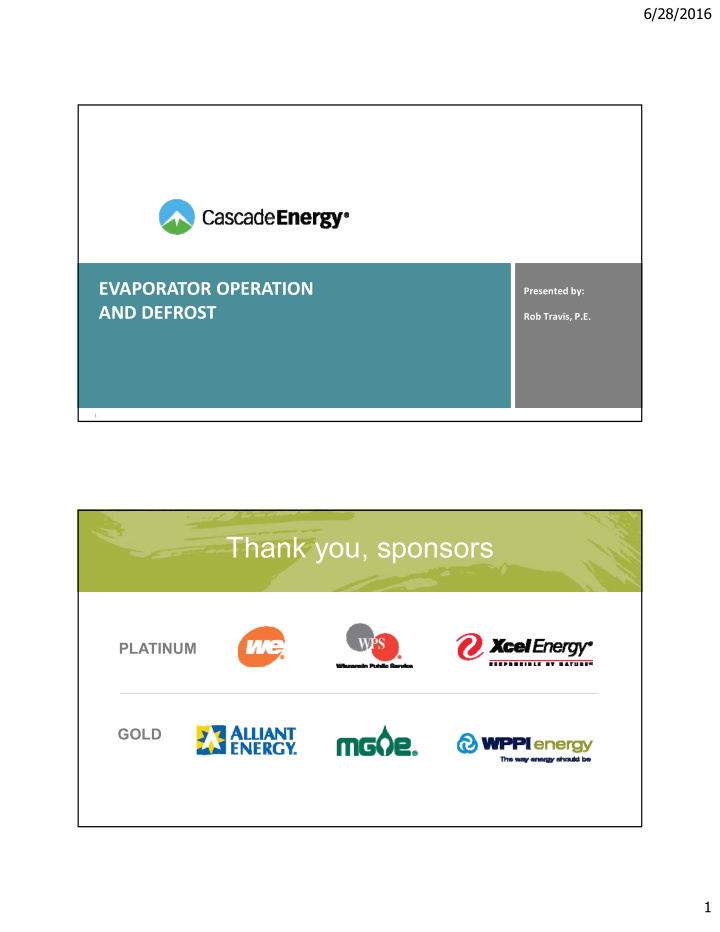



6/28/2016 EVAPORATOR OPERATION Presented by: AND DEFROST Rob Travis, P.E. 1 Thank you, sponsors Our online sponsors PLATINUM GOLD 1
6/28/2016 TOP 4 LOW COST EVAPORATOR ACTION ITEMS 1. Evaporator Fan Cycling 2. Defrost Setpoints 3. Verify Room Temperature Set‐points 4. Address Fan Motor and VFD Issues Courtesy: Evapco Courtesy: Guntner 3 HOW EVAPORATOR COILS WORK ‣ Functions to remove heat from the space ‣ Heat energy moves from hot to cold, or from cold to colder ‣ Room temperature control: � Liquid solenoid opens and closes to supply refrigerant when needed � Exiting “Supply” Refrigerant Fans draw air through Entering “Return” Temperature Air Temperature the coil and pushes it out Air Temperature -10°F ‐2 ° F into the room +3 ° F Cold Heat Falls Average Room Rises Air Temperature 0 ° F 4 2
6/28/2016 1. EVAPORATOR FAN CYCLING & VFD CONTROL ‣ Enable fan cycling on the control system for each evaporator zone Fans turn off when liquid � solenoid closes Fans turn on when liquid � solenoid opens Fan Motor Heat ‣ Fans operate only when refrigeration is needed in the room ‣ Saves evaporator fan energy AND fan motor heat load 5 ISSUES / CONCERNS ‣ What about air temperature stratification? � Effect is nominal in most situations. Enable stir cycle if needed. Remember, heat rises up to the evaporator � Air temperature ≠ product temperature � ‣ What about condensation/moisture on the dock? � May be an issue in warm, humid climates. Disable fan cycling for summer months (June – August) � ‣ What about heated rooms? Operate fans continuously in when in heating mode � � Fans help air circulate instead of keeping the heat at the ceiling 6 3
6/28/2016 EVAPORATOR FAN CYCLING SAVINGS POTENTIAL ‣ Evaporators constitute 15‐20% of total facility energy ‣ Fan cycling may reduce evaporator energy by 30% on average ‣ Example of a typical refrigerated distribution center savings when fan cycling was enabled 380,000 kWh annual energy savings � 5.6% reduction in division electrical � consumption $25,300 annual electrical cost savings � 7 2. DEFROST SETPOINTS How much hot gas is really needed? ‣ Too much hot gas pumps heat into the room and incurs a false load on the compressors – double energy penalty. ‣ Liquid runtime setpoints ‣ Pump‐out setpoints ‣ Hot gas setpoints ‣ Seasonal setpoints Good Frost Pattern: 25‐30% Blockage 8 4
6/28/2016 DEFROST SETPOINTS Defrost Cycle • If any cooler or freezer evaporators are being defrosted more than twice per day: • Investigate the defrost cycle or involve contractor Pump Out Time • If the pump out time is <20 minutes: • Change the setpoint to 20 minutes Hot Gas Time • If the hot gas time is >20 minutes: • Watch a defrost cycle or involve contractor Defrost Initiation • Liquid runtime vs. scheduled 51°F Surface in a 0°F Freezer • Will required testing 9 3. VERIFY TEMPERATURE SETPOINTS Ensure the room temperature setpoints are appropriate and not lower than necessary • Typical room temperatures: Design Temperature Zones Temperature General Cooler 34‐38°F Meat Cooler 28°F Produce Cooler 47‐55°F Refrigerated Dock 38‐45°F Main Freezer < 0°F Ice Cream Freezer ‐10°F to ‐20°F • Low temperature setpoints = more refrigeration and more evaporator fan energy • For freezers, try a ‐2 ° F or ‐3 ° F setpoint 10 5
6/28/2016 4. ADDRESS FAN MOTOR AND VFD ISSUES ‣ Check evaporators for fan motors that have failed and replace ‣ Ensure VFDs are being controlled correctly in the control system ‣ Inspect the actual VFD to make sure it has not been bypassed ‣ Verify the minimum and maximum speeds setpoints Minimum Speed: 40% � Maximum Speed: 90% � 11 CONCLUSION ‣ Significant energy savings can be realized by ensuring the evaporators are operating efficiently. ‣ Most recommendations are either simple setpoint changes or maintenance issues. ‣ Defrost setpoint adjustments may be improved incrementally over time and require vigilance to ensure defrosts are complete. 12 6
Recommend
More recommend